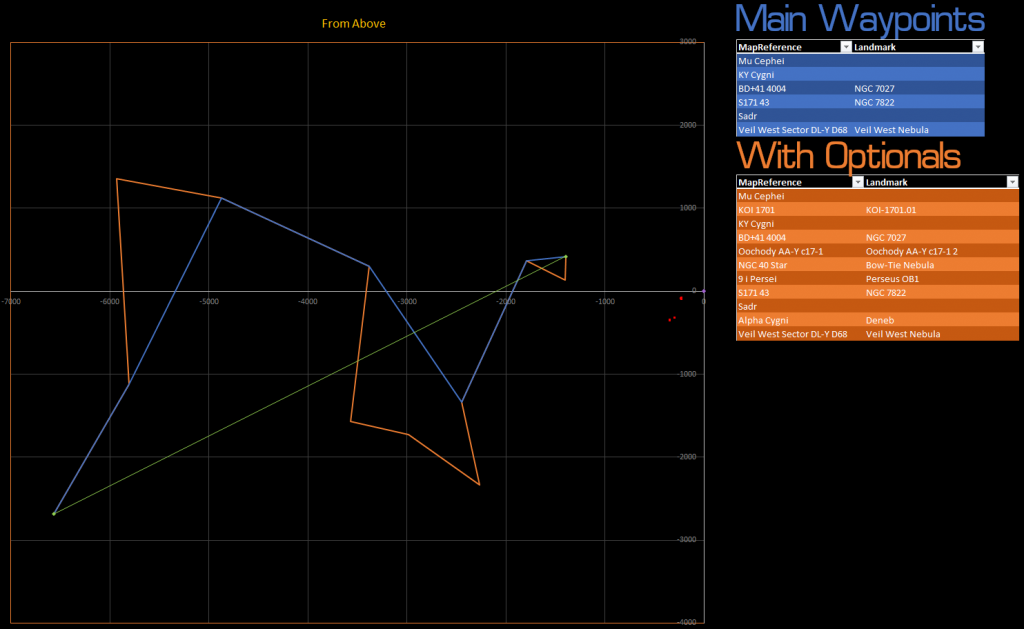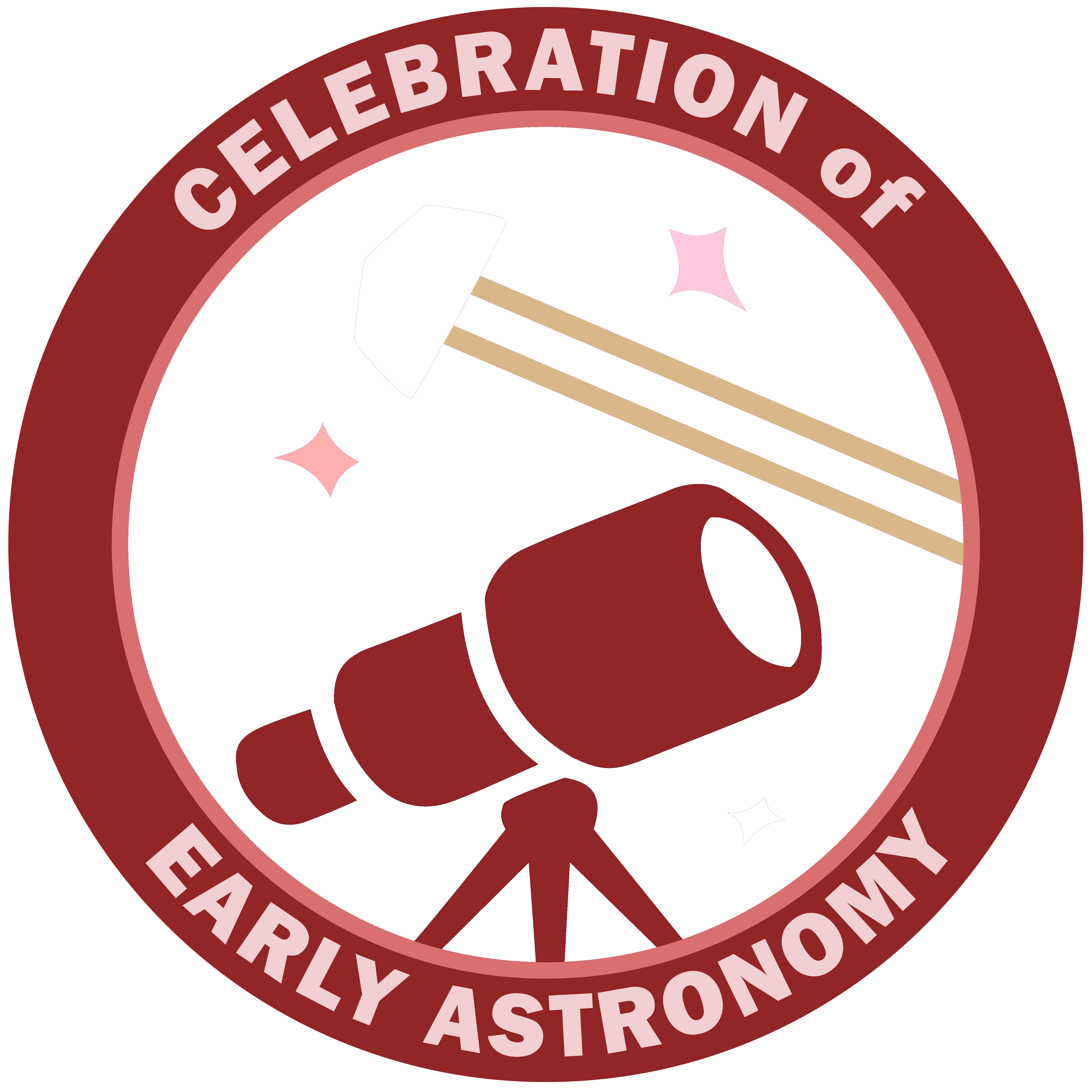Now we depart the Bubble Nebula and begin making our way back towards “The Bubble” while making a stop first at the Veil West Nebula as our next basecamp. Along the way visiting other points of interest.
Dates
Start Date: February 5, 2022
End Date: February 19, 2022
Distances
Basecamp Line: 6,035.41 Ly
Main Waypoints: 10,241.70 Ly
Optional Waypoints: 15,358.67 Ly
Map, (click for full size):

Basecamp: Veil West Sector DL-Y D68
Main Waypoints
- Map References quick reference list, more details below
- Mu Cephei
- KY Cygni
- BD+41 4004
- S171 43
- Sadr
- Veil West Sector DL-Y D68
Main Waypoints Details
- Map Reference: Mu Cephei
- One of the largest red supergiants. Also known as Herschel’s Garnet Star. In the constellation Cepheus. Since 1943 the spectrum of this star has served as the M2 Ia standard by which other stars are classified. It is one of the largest known stars, and if it was placed in the center of our solar system would extend to between the orbits of Jupiter and Saturn.
- SIMBAD Link
- EDSM Link
- Map Reference: KY Cygni
- One of the top 10 largest known stars. If placed in the center of the solar system, it would extend past the orbit of Jupiter. It is also quite close to the Crescent Nebula. It is estimated to go supernova within 2 million years.
Station nearby: Medusa’s Rock in Crescent Sector GW-W C1-8 - SIMBAD Link
- One of the top 10 largest known stars. If placed in the center of the solar system, it would extend past the orbit of Jupiter. It is also quite close to the Crescent Nebula. It is estimated to go supernova within 2 million years.
- Map Reference: BD+41 4004
- POI: NGC 7027
- The Jewel Bug Nebula, is a planetary nebula within the Cygnus constellation portion of the sky. It was discovered in 1878 by Édouard Stephan at Marseille Observatory. It is both one of the visually brightest planetary nebulae, as well as one of the smallest.
- SIMBAD Link
- EDSM Link
- Map Reference: S171 43
- POI: NGC 7822
- NGC 7822 is a star forming complex in the Cepheus constellation containing both the emission regions known as Sharpless 171 and Berkeley 59. The complex also includes one of the hottest stars discovered within 1 kiloparsec of our own solar system, BD+66 1673 (in game as HIP 139), which is an eclipsing binary system with an O5V spectral star with surface temperature over 45,000 Kelvin and a luminosity about 100,000 times that of our sun.
- SIMBAD Link
- EDSM Link
- Map Reference: Sadr
- Sadr, also known as Gamma Cygni is a star in the Cygnus constellation, and forms the intersection of the Northern Cross asterism. It is the main star of a multi-star system designated WDS J20222+4015, with the secondary component being a binary pair designated CCDM J20222+4015BC. Sadr is a supergiant that is one of the brightest stars in the night sky with an apparent visual magnitude of 2.23. Compared to our own sun, it is 12 times as massive, 150 times the radius, and emitting 33,000 times the energy.
- SIMBAD Link
- EDSM Link
- Map Reference: Veil West Sector DL-Y D68
- POI: Veil West Nebula
- Designated as NGC 6960, a nebula in the Cygnus constellation and constitutes the visible portions of the Cygnus Loop. It is the remnants of a supernova. It is also sometimes referred to as the Cirrus Nebula or the Filamentary Nebula.
Additional viewing site suggestion: Veil West Sector PD-S B4-2, puts it nearly in line with Barnard’s Loop for a spectacular view. - SIMBAD Link
Optional Waypoints
- Map References quick reference list, more details below
- Mu Cephei
- KOI 1701
- KY Cygni
- BD+41 4004
- Oochody AA-Y c17-1
- NGC 40 Star
- 9 i Persei
- S171 43
- Sadr
- Alpha Cygni
- Veil West Sector DL-Y D68
Optional Waypoints Details
- Map Reference: KOI 1701
- POI: KOI-1071.01
- The first planet in this system is KOI-1701-01 is an extrasolar planet candidate around the KOI-1701 star. In the Elite: Dangerous in-game galaxy it is, as of September 2021 the highest gravity landable planet known in the in-game galaxy at 45.32G, If you go to land on this planet, use EXTREME caution.
- SIMBAD Link
- EDSM Link
- Map Reference: Oochody AA-Y C17-1
- POI: Oochody AA-Y c17-1 2
- Glowing Green Gas Giant
- Map Reference: NGC 40 Star
- POI: Bow-Tie Nebula
- NGC 40, also known as the Bow-Tie Nebula (but not to be confused with the Bow Tie Nebula) is a planetary nebula sicovered by William Herschel in 1788. The central carbon-rich Wolf-Rayet star is one of the hottest known stars with a surface temperature over 50,000 degrees Celsius. About 30,000 years from now, the star will die leaving behind a white dwarf approximately the size of Earth.
- SIMBAD Link
- EDSM Link
- Map Reference: 9 i Persei
- POI: Perseus OB1
- Perseus OB1 is an OB association (clusters of 10 to 100 massive O or B spectral class stars, along with hundreds to thousands of other lower spectral class stars) in the Perseus constellation, containing the clusters NGC 869 and NGC 884. 9 Persei (Flamsteed Designation) also known by Bayer Designation of i Persei is the brightest member of the OB association.
(Note: “9 i Persei” is not a proper reference to the star, but Elite does this weird thing at time whereit smashes together a star’s Bayer and Flamsteed designations like that) - SIMBAD Link
- Map Reference: Alpha Cygni
- POI: Deneb
- The brightest star in the Cygni constellation, and 19th brightest star in the night sky. It represents the tail of the swan in the Cygnus constellation. This star is the star ionizing the North America Nebula and Pelican Nebula. Was also featured multiple times in the science fiction series Star Trek, most notably in the first ever episode of Star Trek: The Next Generation.
- SIMBAD Link
- EDSM Link
